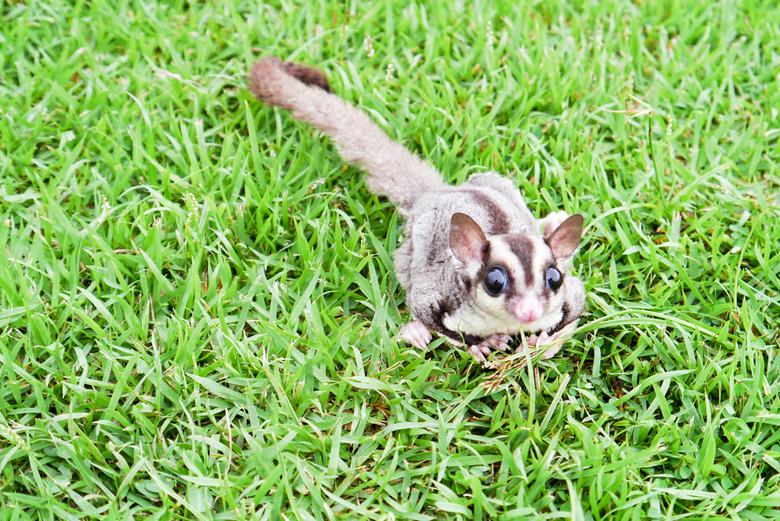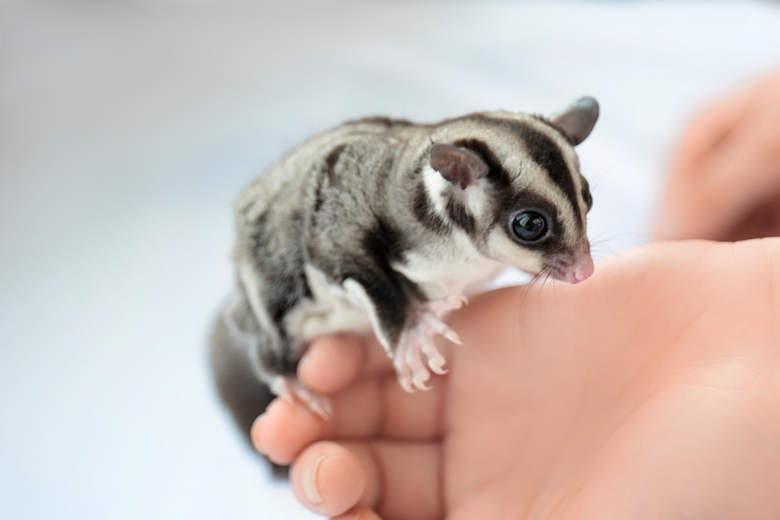The cute and curious sugar glider is one of the most popular exotic animals out there. This little friend is extremely sociable and loves to be in warm arms. Despite this, the sugar glider is not an animal that requires little care in captivity so it must be treated with care and attention. First of all, let's inform ourselves a little about this sweet friend.
What is a Sugar glider?
The scientific name of this small ball of sweet is Petaurus breviceps; however, it is known as the sugar glider. Its appearance is similar to that of a small omnivorous possum, it favors the branches of trees and is a nocturnal animal, belonging to the family of the marsupial infraclass.
The sugar glider owns its particular name due to its predilection for sugary foods such as sap and nectar, in addition to its great ability to slip through the air that allows it to effectively reach food and escape from predators. This ability is very characteristic of the flying squirrels, which have habits and aspects similar to our sugar glider; however, they are not intimately related at all.
Sugar glider facts: The small and friendly sugar glider

Where do they come from?
Sugar gliders are frequently found in parts of mainland Australia, on the island of New Guinea, including adjacent islands such as New Britain and some islands of Indonesia. It is an exotic pet very popular for its appearance. It is forbidden to have it as a pet in some parts of Australia and the United States, so if you want to have a sugar glider as a pet it is essential to check if the laws of your area allow you to have it.
How tall are they?
An adult sugar glider can measure approximately 13 to 18 cm from the tip of the muzzle to the base of the tail, which in turn is as long as the body. Males are usually somewhat larger and heavier than females (115-160 g for males and 100-130 g for females).
How long can they live?
Giving them good care these animals can live between 8 to 15 years, although the normal thing is that they live from 10 to 15 years. So, remember, the key is proper and healthy care.
What is their head like?
Their heads are short with a pointed pink snout, with eyes and ears of large proportions. These features make them look almost cartoon-like.
Tail
It is one of its most significant features as its tail is almost as long as its body and its abundant hair covers it completely. The sugar glider handles his fluffy tail at will, however, although they can move it as they want, they cannot hold their own weight with it as some species of possum or monkeys.
AdvertisementCan they fly?
Well, they don't really fly. They have a membrane on each side of the body that runs from the fifth finger of the hand to the thumb of the foot, which is called patagio. Due to this membrane, the sugar glider can make planned flights of up to 55 m, going from branch to branch one after another, using the tail as a rudder.
They have two involuted toes they don't use, using the remaining three as the legs of a parrot to grasp the branches.
What color are they?
Their background color is silver gray, with a black band running from the snout to the base of the tail. The central area is dirty white. The eyes are surrounded by a dark mask. The ears and their base are also profiled in black. Colors vary according to the subspecies and there are some different color patterns obtained recently through selective breeding such as the Black Beauty sugar glider or the Leucistic sugar glider.
They have two glands
These glands are in charge of producing a substance with which the dominant male of the group marks his territory, objects and other members of the group. One of the glands is located at the top of the head, and the other in the central region of the neck, behind the chin.
How are they as pets?

One thing to have in mind if you want to have this tender animal as your pet is that they are not low maintenance. For example, it is known that they are very sociable animals that love to live with the same species. If they become alone, they will easily become depressed and will be in great danger of dying. Because they are very sociable, they must have a lot of interaction with their masters, so you should not lack interest and affection for your part.
Sugar gliders like to “fly” and feel free so, the place where you will have your pet represents a challenge. As they are restless and active creatures, they need a lot of space in their cage, and you have to keep in mind that they like to climb and jump, so the vertical space is more important than the surface of the floor of the cage. A recommendation for the size of the cage for a pair of sugar gliders is of 60 x 60 cm x 1 m high. This is not really a rule, the bigger the better for them.
The cage should be placed in an accessible place in the house, where it does not receive direct sunlight and is safe from air drafts. The best temperature range for them is between 20 and 30 degrees so you may need to change the location in summer and winter to find a warm place.
As for their diet, this is a little difficult to replicate in captivity, but can be achieved by calculating carbohydrates. It is important to give them a diet rich in carbohydrates but just the right amount for them. So, don't forget the fruits, vegetables, cereals, and proteins that are suitable for them. Before acquiring a sugar glider, be sure to research about their diet specifics.
Finally, the sugar gliders are very clean animals so you will not have to spend much time cleaning them, only when required. Although it is very difficult to potty train them, beside this, the rest will be very easy to clean.
A sugar glider's health
This small glider tends to be very prone to getting sick, the sugar glider hides their diseases very well, as it is a defense mechanism in nature to not look weak against possible predators. For this reason, it is difficult to know when they are ill. Therefore, you must be especially observant.
Some of the diseases that sugar glider usually suffer from are liver infections, calcium deficiency, depression, diarrhea, constipation, facial swelling among others. All of these need the treatment of a specialized veterinarian. Some of the symptoms that will help you detect if your pet is sick are lethargy, lack of appetite, weight loss, tremors, vomiting among others.
References and further readings:
- Wikipedia, Sugar glider
- petMD, All About Sugar Gliders